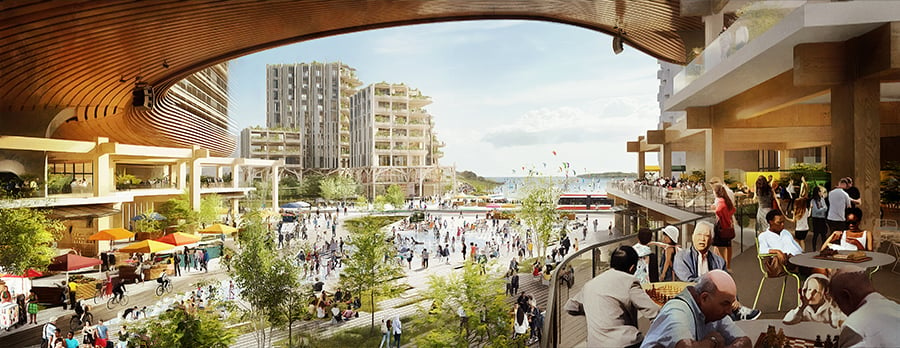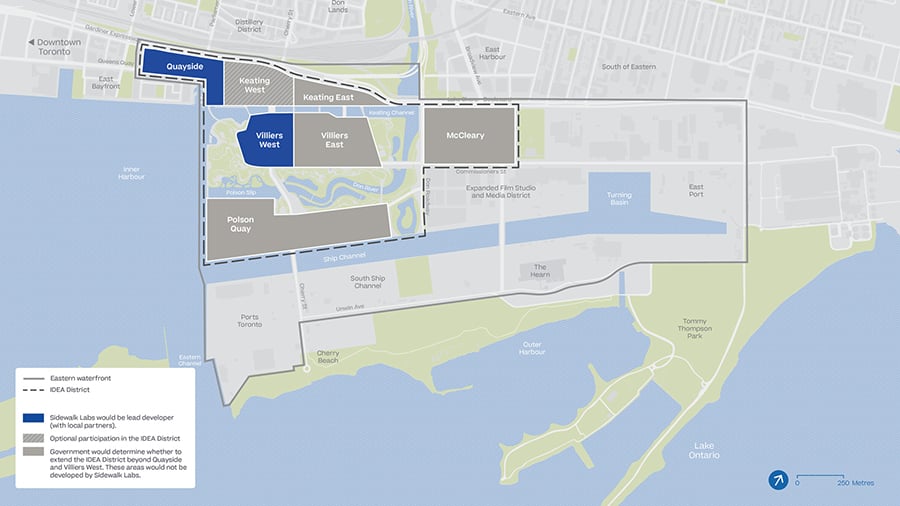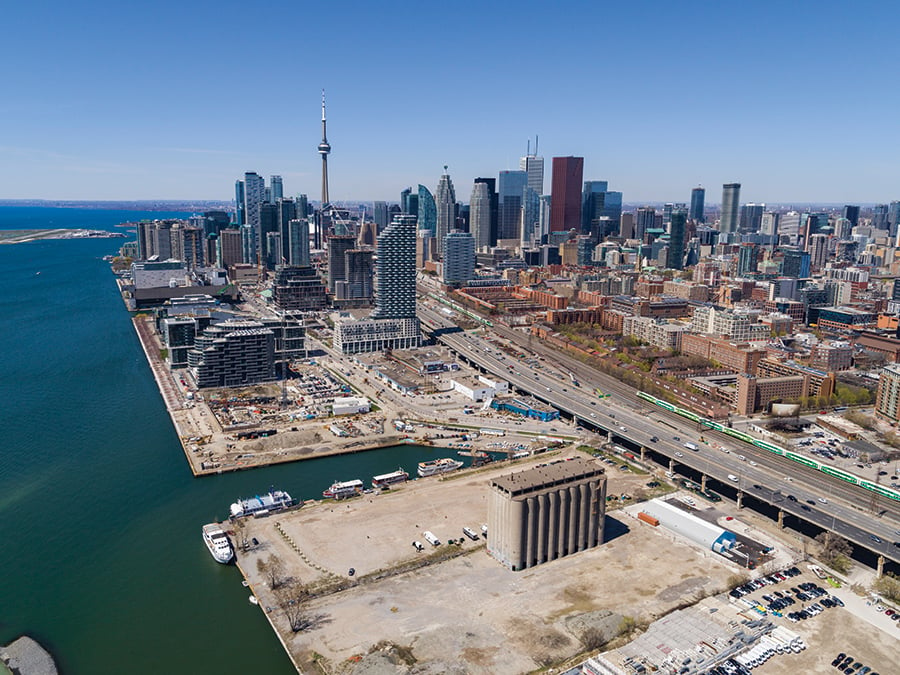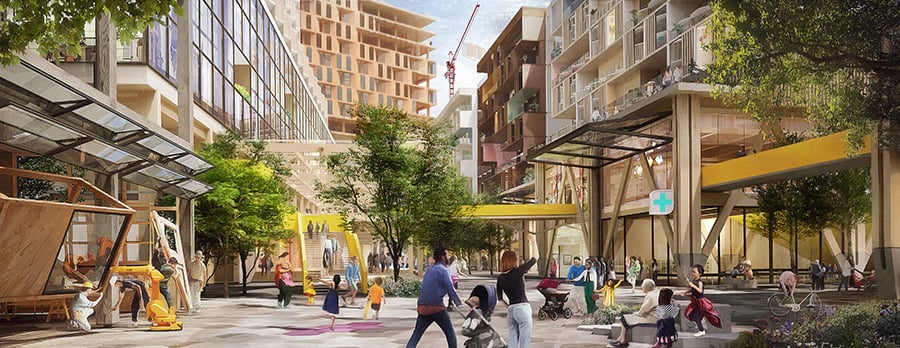
June 27, 2019
Sidewalk Labs Releases Master Plan for Its Toronto Smart City Development
After extensive community outreach, the Google-owned tech and infrastructure company has put forth an ambitious plan for a sustainable and inclusive neighborhood.

What will it take to build “the most innovative district in the entire world”? A neighborhood “supported by the strongest governance regime for urban data in the world”? Not just a “global model for inclusive growth,” but a “globally significant community that dramatically improves the quality of life”?
Each of those claims were made Monday by Dan Doctoroff, the chief executive for Sidewalk Labs. The Google-owned company released its “Toronto Tomorrow” master plan for Quayside, a smart neighborhood proposed for once-industrial waterfront land on the east side of the city. Since Sidewalk Labs won an RFP in October 2017 to develop the site, there’s been no shortage of coverage or controversy circling the company’s smart-city ambitions.
Before Sidewalk Labs’ recent digital presser even began, it wanted reporters to know that building a globally significant community would require plenty of documentation. Having to haul the physical master plan upstairs to my apartment was an endeavor unto itself. Opening the package revealed a massive, sleek four-book compilation—designed by Pentagram—that spans 1,500 pages. The 253-page overview states, however, it’s still “a work-in-progress meant to be refined by further consideration.”
Bluster followed by caution—that was the dynamic at play during Monday’s press conference. The company insisted that the 190-acre district, now known as the Innovative Development and Economic Acceleration (IDEA) District, can become a global model for equity, technology, sustainability, and all other buzzwords in modern urban policy. At the same time, it also sought to assure Toronto citizens and government they still have a stake determining the project’s future.
To be fair, Sidewalk Labs has been responsive to criticism from said citizens on issues such as data privacy and community-oriented opportunities.

Regarding data privacy, Doctoroff spoke of a proposal Sidewalk Labs is making for a “government-sanctioned independent urban data trust” (broken down in Volume Two of the mega-master plan) that would oversee every use of urban data in the district. And he stressed that, “We will not sell personal information, we will not use personal information for advertising, we will not disclose personal information to third parties without explicit consent.”
He also emphasized the importance of public sector and local partnerships (which got its own book—that’s Volume Three), noting that Canadian firms would deliver 84 percent of real estate in the district. “Our involvement beyond Quayside is not guaranteed,” Doctorff stated. “We have to earn our way to continue with this project.”
Still, Sidewalk Lab is looking at the two parcels it will develop within the IDEA District—Quayside and Villiers West—as a true testing ground to address modern-day ills of our cities.
That gets to the overwhelming size of the masterplan, with its beautiful renderings and an overload of equitable urbanism principles. Block Sidewalk, a local opposition group, dismissed the 1,500 pages as “designed to drown the public in detail.” But Doctoroff considers it a blueprint for better city planning in the digital age, something “highly responsive to the urban issues so many cities are facing today.”
Undoubtedly, master planning is better when it does address the issues facing our cities, which seem to grow ever more urgently around housing affordability, income inequality, and climate change. It’s exciting to hear about Sidewalk Lab’s use of timber, a decision it hopes will accelerate construction, reduce costs, offer sustainability benefits, and create jobs through a local factory. Quayside is also envisioned as a “climate positive community” by dramatically reducing greenhouse gases and designing for walkability.

When it comes to housing, Sidewalk Labs offers some creative approaches beyond its 40 percent commitment to below-market units. There’s likely to be an innovative mix of options—from co-living to family-accommodating apartments—with a priority for flexible interior partitions to make apartment renovation easier. A shared-equity buying option is a notable facet of any affordable housing plan, though it’ll only account for 5 percent of built units at Quayside.
What’s impossible to shake is the feeling that Sidewalk Labs is trying to prove something—not only to residents of Toronto, but to the world. Maybe it wants to get across that data-obsessed development by a Google-owned company shouldn’t be that scary. (Google has already proven it has a long-term interest in developing housing.) Or to demonstrate that a single private company overseeing an entire public neighborhood can get it right—something that would sharply counter the less-than-stellar showing of New York’s newest neighborhood, Hudson Yards.
The two projects have more than one thing in common, namely Dan Doctoroff. No Toronto local, he’s a New Yorker and a former deputy mayor for economic development for the Bloomberg administration. In that role he had a heavy hand rezoning large swaths of the city, which contributed to the spike in real estate prices and rampant gentrification. After founding Sidewalk Labs in 2015, Doctoroff chose Toronto to build the company’s showpiece. But times have changed, and there is a growing sense that development cannot continue on as it has in the past.
Will Doctoroff, and ultimately Google, succeed? A letter by the chairman of Waterfront Toronto, which issued the RPF for the site, called the IDEA District “premature.” It noted there are proposals “where it is clear that Waterfront Toronto and Sidewalk Labs have very different perspectives about what is required for success” from the size of the development site to digital governance.
Near the close of Monday’s presser, Doctoroff acknowledged Sidewalk Labs’ grand vision is still very much in play. But he couldn’t help but add one final boast before signing off. “We realize we have given you an incredible amount of information … but that’s what it takes to do something that is truly different,” he said. “If we do want to solve these enormous urban challenges, it is never going to be the way we’ve done it in the past. And that’s what we’re offering here, a way forward for achieving the very elusive goal of inclusive growth.”
You may also enjoy “Gold and Silver Medalists Announced for 2019 Rudy Bruner Award for Urban Excellence.”
Would you like to comment on this article? Send your thoughts to: [email protected]
















